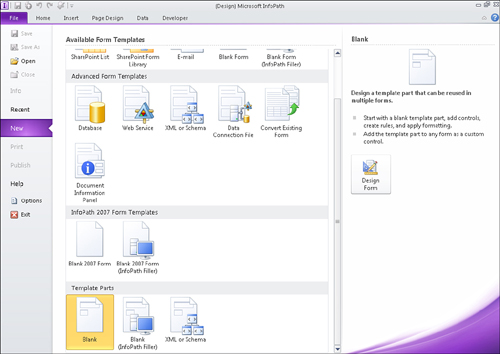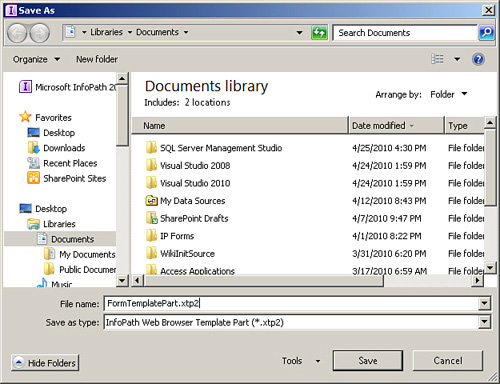1. Create a New Template Part
| Scenario/Problem: | You need to create a new template part. |
|
| Solution: | From File, New, select Blank from the Template Parts section. |
The first step in creating a new template part is
selecting the Blank template in the Template Parts section from the
File, New menu page, as shown in Figure 1.

2. Add Common Data Connections
| Scenario/Problem: | You need to add data connections to your template part. |
|
| Solution: | Use the Data ribbon bar menu to add the appropriate data connections. |
You may only add data connections to receive data
and not to submit data. Adding data connections to your template part
is the same process as if you were using data connections in a
SharePoint form. It is best to leverage data connection files already
created and deployed to your SharePoint site.
Tip
If you do not have data connection files
available, it is best to create your data connections in the template
part and then convert them to connection files.
3. Add Common Controls
| Scenario/Problem: | You need to add controls to your template part. |
|
| Solution: | Use the Control box to add controls to your template part. |
Add controls to your template part just as you would
a SharePoint form. Use appropriate table layouts accordingly to arrange
the controls on your template part.
Tip
The size of the template part will be the size of the resultant control on your SharePoint forms. Use space sparingly.
4. Add Common Fields
| Scenario/Problem: | You need to add fields to your template part. |
|
| Solution: | From the Fields pane, add new fields to your template part’s Main data structure. |
Sometimes you need to have fields that are
not bound to controls in your template part. Add any additional fields
to your main data source just as you would in normal SharePoint forms.
5. Save Your Form Template Part
| Scenario/Problem: | You need to save your form template part. |
|
| Solution: | Select Save or Save As from the File menu. |
Saving your form template part creates a file with a
.xtp2 extension. Click File, Save to save your template part. Enter a
name and click OK, as shown in Figure 2.

Tip
After your template part is ready for primetime, you may want to save it to a SharePoint library to share with your team.